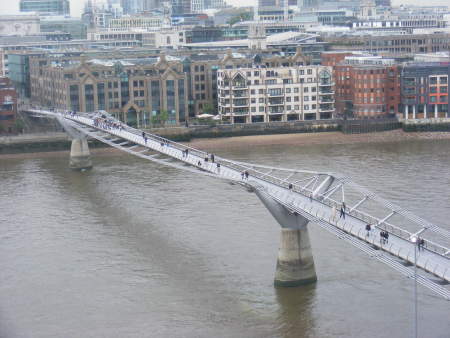What made the Millennium Bridge so wobbly?
Eight years after the Millennium Bridge's infamous wobble caused it to be closed to the public on its opening day, a new study finally explains what happened by looking at how humans stay balanced while walking.


On its opening day in June 2000 the Millennium Bridge experienced unexpected swaying due to the large number of people crossing it.
The Norman Foster-designed bridge then remained closed until February 2002 while engineers fitted dampers to suppress the wobble.
The same pedestrian-structure interaction has also been identified on several other bridges, including Bristol's Clifton Suspension Bridge.
New research by civil engineers at the University of Bristol shows that the phenomenon is not related to the structural form of the bridge, but rather the behaviour of the pedestrians.
The paper, published in the Royal Society journal Proceedings of the Royal Society A, examines the basic way humans maintain balance.
Balance is achieved by changing the position of foot placement for each step, based only on the final displacement and speed of the centre of mass from the previous step.
The same balance strategy as for normal walking on a stationary surface was applied to walking on a laterally swaying bridge.
Without altering their pacing frequency, averaged over a large number of cycles, the pedestrian can effectively act as a negative damper to the bridge motion, which may be at different frequency. Hence the pedestrian can inadvertently feed energy into bridge oscillations.
"It is clear that the motion of the bridge affects the force from the pedestrian, rather than the pedestrian simply applying an external force," says Dr John Macdonald, senior lecturer in civil engineering.
It has generally been thought the Millennium Bridge 'wobble' was due to pedestrians synchronising their footsteps with the bridge motion. Now the Bristol researchers say that this is not supported by measurements of the phenomenon on other bridges.
The researchers found, to their surprise, that pedestrians walking randomly and keeping balance as normal can cause large bridge sway.
This finally seems to explain the Millennium Bridge 'wobble' and gives new insight for future bridge designers to avoid vibration problems.
Comments
Share
The SE1 website is supported by people like you
More to read
- Developer drops affordable housing from Grange Road scheme 25 Feb 2023
- Norman Foster objects to changes to Millennium Bridge 'ensemble' 11 Jul 2020
- Men jailed for armed robbery at Queen Elizabeth Street food shop 30 May 2013
- Millennium Bridge: deck to be lifted for structural inspection 17 Oct 2012
- Hundreds gather for funeral of Hilary Wines, past Mayor of Southwark 4 Sep 2010
- Southwark's town crier Peter Moore dies aged 70 30 Dec 2009
- Millennium Bridge daytime closure this week 12 Mar 2007
- Giant pints spotted on Bankside 16 Sep 2005
- Millennium Bridge to close for wobble check 28 Feb 2005
- Wobbly bridge boss knighted in birthday honours 12 Jun 2004
Follow us
Email newsletter
For the latest local news and events direct to your inbox every Monday, you need our weekly email newsletter SE1 Direct.

